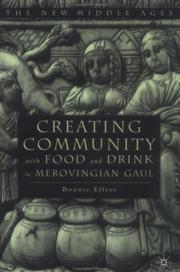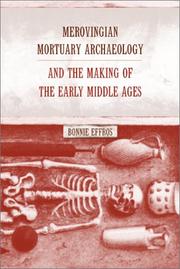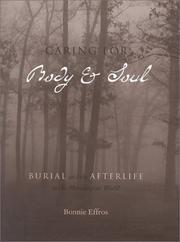| Listing 1 - 10 of 10 |
Sort by
|
Book
ISBN: 9780199696710 0199696713 0191804886 Year: 2012 Volume: *5 Publisher: Oxford Oxford University Press
Abstract | Keywords | Export | Availability | Bookmark
 Loading...
Loading...Choose an application
- Reference Manager
- EndNote
- RefWorks (Direct export to RefWorks)
History of France --- History of civilization --- Archeology --- anno 1910-1919 --- anno 1900-1909 --- anno 1800-1899 --- Merovingians --- Archaeology --- Mérovingiens --- Archéologie --- France --- Antiquities. --- Antiquités --- Mérovingiens --- Archéologie --- Antiquités

ISBN: 0312227361 Year: 2002 Volume: *9 Publisher: New York Palgrave Macmillan
Abstract | Keywords | Export | Availability | Bookmark
 Loading...
Loading...Choose an application
- Reference Manager
- EndNote
- RefWorks (Direct export to RefWorks)
Beschaving [Middeleeuwse ] --- Civilisation médiévale --- Civilization [Medieval ] --- Civilization [Medieval ]--History --- Europa--Beschaving--476-1492 --- Europe--Civilisation--476-1492 --- Europe--Civilization--476-1492 --- Medieval civilization --- Middeleeuwen--Beschaving --- Middeleeuwen--Cultuur --- Middeleeuwse beschaving --- Middeleeuwse cultuur --- Middle Ages--Civilization --- Moyen-Age--Civilisation --- Merovingians --- Dinners and dining --- Fasts and feasts --- Civilization, Medieval. --- Mérovingiens --- Repas --- Fêtes religieuses --- Food --- Social aspects. --- History. --- Alimentation --- Aspect social --- Histoire --- France --- Social life and customs. --- Moeurs et coutumes --- Civilization, Medieval --- -Fasts and feasts --- -Merovingians --- -Church festivals --- Ecclesiastical fasts and feasts --- Fast days --- Feast days --- Feasts --- Heortology --- Holy days --- Religious festivals --- Christian antiquities --- Days --- Fasting --- Liturgics --- Rites and ceremonies --- Theology, Practical --- Church calendar --- Festivals --- Holidays --- Sacred meals --- Banquets --- Dining --- Eating --- Meals --- Caterers and catering --- Entertaining --- Etiquette --- Cooking --- Gastronomy --- Menus --- Table --- Middle Ages --- Civilization --- Chivalry --- Renaissance --- History --- -Social aspects --- Religious aspects --- -History --- -Civilization, Medieval --- Church festivals --- Mérovingiens --- Fêtes religieuses --- Civilisation médiévale --- Food&delete& --- Social aspects --- Social life and customs

ISBN: 0520232445 9780520232440 Year: 2003 Volume: 35 Publisher: California University of California press
Abstract | Keywords | Export | Availability | Bookmark
 Loading...
Loading...Choose an application
- Reference Manager
- EndNote
- RefWorks (Direct export to RefWorks)
Merovingians --- Funeral rites and ceremonies --- Gaul --- France --- Social life and customs --- Antiquities --- History --- Funeral rites and ceremonies. --- Antiquities. --- Social life and customs. --- -Merovingians --- -940.1 --- Funerals --- Mortuary ceremonies --- Obsequies --- Manners and customs --- Rites and ceremonies --- Burial --- Cremation --- Dead --- Mourning customs --- History Europe Middle Ages (476 - 1453) --- -Gaul --- -Gallia --- Gaule --- -Antiquities --- Archaeology, Medieval --- Tombs --- Mérovingiens --- Funérailles --- Archéologie médiévale --- Tombeaux --- Funeral customs and rites --- Rites et cérémonies funéraires --- Antiquités --- Rites et cérémonies --- Histoire --- Pʻŭrangsŭ --- Frankrig --- Francja --- Frant︠s︡ii︠a︡ --- Prantsusmaa --- Francia (Republic) --- Tsarfat --- Tsorfat --- Franḳraykh --- Frankreich --- Fa-kuo --- Faguo --- Франция --- French Republic --- République française --- Peurancih --- Frankryk --- Franse Republiek --- Francland --- Frencisc Cynewīse --- فرنسا --- Faransā --- Franza --- Republica Franzesa --- Gallia (Republic) --- Hyãsia --- Phransiya --- Fransa --- Fransa Respublikası --- Franse --- Францыя --- Frantsyi︠a︡ --- Французская Рэспубліка --- Frantsuzskai︠a︡ Rėspublika --- Parancis --- Pransya --- Franis --- Francuska --- Republika Francuska --- Bro-C'hall --- Френска република --- Frenska republika --- França --- República Francesa --- Pransiya --- Republikang Pranses --- Γαλλία --- Gallia --- Γαλλική Δημοκρατία --- Gallikē Dēmokratia --- فرانسه --- Farānsah --- צרפת --- רפובליקה הצרפתית --- Republiḳah ha-Tsarfatit --- פראנקרייך --- 法国 --- 法蘭西共和國 --- Falanxi Gongheguo --- フランス --- Furansu --- フランス共和国 --- Furansu Kyōwakoku --- Francija --- Ranska --- Frankrike --- To 987 --- History. --- Merovingians - Funeral rites and ceremonies --- Funeral rites and ceremonies - Gaul --- Gaul - Social life and customs --- Gaul - Antiquities --- France - History - To 987

ISBN: 0271021969 Year: 2002 Publisher: University Park Pennsylvania State university press
Abstract | Keywords | Export | Availability | Bookmark
 Loading...
Loading...Choose an application
- Reference Manager
- EndNote
- RefWorks (Direct export to RefWorks)
393 --- 393 Dood. Dodengebruiken. Dodenritueel. Lijkverbranding. Begrafenis. Crematie. Rouw. Opbaren. Lijkstoet. Sterven. Dodenmaskers --- Dood. Dodengebruiken. Dodenritueel. Lijkverbranding. Begrafenis. Crematie. Rouw. Opbaren. Lijkstoet. Sterven. Dodenmaskers --- Funeral rites and ceremonies --- Merovingians --- Archaeology, Medieval --- Funérailles --- Mérovingiens --- Archéologie médiévale --- History --- Funeral customs and rites --- Antiquities. --- Rites et cérémonies --- Histoire --- Rites et cérémonies funéraires --- Antiquités --- France --- Funerals --- Mortuary ceremonies --- Obsequies --- Manners and customs --- Rites and ceremonies --- Burial --- Cremation --- Dead --- Mourning customs --- Antiquities --- Gaul --- Gallia --- Gaule --- History. --- Cryomation --- 393 Death. Treatment of corpses. Funerals. Death rites --- Death. Treatment of corpses. Funerals. Death rites

ISBN: 1282356704 9786612356704 0520928180 1597347434 9780520928183 0585467803 9780585467801 9780520232440 0520232445 9781597347433 0520232445 9781282356702 6612356707 Year: 2003 Publisher: Berkeley
Abstract | Keywords | Export | Availability | Bookmark
 Loading...
Loading...Choose an application
- Reference Manager
- EndNote
- RefWorks (Direct export to RefWorks)
Clothing, jewelry, animal remains, ceramics, coins, and weaponry are among the artifacts that have been discovered in graves in Gaul dating from the fifth to eighth century. Those who have unearthed them, from the middle ages to the present, have speculated widely on their meaning. This authoritative book makes a major contribution to the study of death and burial in late antique and early medieval society with its long overdue systematic discussion of this mortuary evidence. Tracing the history of Merovingian archaeology within its cultural and intellectual context for the first time, Effros exposes biases and prejudices that have colored previous interpretations of these burial sites and assesses what contemporary archaeology can tell us about the Frankish kingdoms. Working at the intersection of history and archaeology, and drawing from anthropology and art history, Effros emphasizes in particular the effects of historical events and intellectual movements on French and German antiquarian and archaeological studies of these grave goods. Her discussion traces the evolution of concepts of nationhood, race, and culture and shows how these concepts helped shape an understanding of the past. Effros then turns to contemporary multidisciplinary methodologies and finds that we are still limited by the types of information that can be readily gleaned from physical and written sources of Merovingian graves. For example, since material evidence found in the graves of elite families and particularly elite men is more plentiful and noteworthy, mortuary goods do not speak as directly to the conditions in which women and the poor lived. The clarity and sophistication with which Effros discusses the methods and results of European archaeology is a compelling demonstration of the impact of nationalist ideologies on a single discipline and of the struggle toward the more pluralistic vision that has developed in the post-war years.
Funeral rites and ceremonies --- Merovingians --- Funerals --- Mortuary ceremonies --- Obsequies --- Manners and customs --- Rites and ceremonies --- Burial --- Cremation --- Cryomation --- Dead --- Mourning customs --- Funeral rites and ceremonies. --- France --- Gaul --- Gallia --- Gaule --- History --- Antiquities. --- Social life and customs. --- Funeral customs and rites. --- Merovingians - Funeral rites and ceremonies --- Funeral rites and ceremonies - Gaul --- Gaul - Social life and customs --- Gaul - Antiquities --- France - History - To 987 --- ancient world. --- anthropology. --- antiquity. --- archaeology. --- aregund. --- art history. --- burial. --- celtic world. --- ceremonies. --- childeric. --- class. --- customs. --- dark ages. --- death. --- dying. --- early middle ages. --- europe. --- excavations. --- france. --- frankish kingdoms. --- french history. --- funerals. --- funerary. --- gaul. --- grave artifacts. --- graves. --- history. --- medieval history. --- medieval society. --- medieval. --- merovingian archaeology. --- merovingian graves. --- merovingians. --- monarchy. --- mortuary. --- nation. --- nonfiction. --- race. --- religion. --- rites. --- royalty. --- rulers. --- saint brice. --- social science. --- sociology. --- tombs.
Book
ISBN: 1501718541 9781501718540 9781501718533 1501718533 9781501702105 1501702106 1501761676 Year: 2022 Publisher: Ithaca : Cornell University Press,
Abstract | Keywords | Export | Availability | Bookmark
 Loading...
Loading...Choose an application
- Reference Manager
- EndNote
- RefWorks (Direct export to RefWorks)
'Incidental Archaeologists' examines the archaeological contributions of 19th-century French military officers, who, raised on classical accounts of warfare and often trained as cartographers, developed an interest in the Roman remains they encountered when commissioned in the colony of Algeria. By linking the study of the Roman past to French triumphant narratives of the conquest and occupation of the Maghreb, the book demonstrates how Roman archaeology in the 40 years following the conquest of the Ottoman Regencies of Algiers and Constantine in the 1830s helped lay the groundwork for the creation of a new identity for French military and civilian settlers.
Archaeology and state --- Archaeology --- Archeology --- Anthropology --- Auxiliary sciences of history --- History --- Antiquities --- Public archaeology --- State and archaeology --- Political aspects --- Algeria --- France --- Bro-C'hall --- Fa-kuo --- Fa-lan-hsi --- Faguo --- Falanxi --- Falanxi Gongheguo --- Faransā --- Farānsah --- França --- Francia (Republic) --- Francija --- Francja --- Francland --- Francuska --- Franis --- Franḳraykh --- Frankreich --- Frankrig --- Frankrijk --- Frankrike --- Frankryk --- Fransa --- Fransa Respublikası --- Franse --- Franse Republiek --- Frant︠s︡ --- Frant︠s︡ Uls --- Frant︠s︡ii︠a︡ --- Frantsuzskai︠a︡ Rėspublika --- Frantsyi︠a︡ --- Franza --- French Republic --- Frencisc Cynewīse --- Frenska republika --- Furansu --- Furansu Kyōwakoku --- Gallia --- Gallia (Republic) --- Gallikē Dēmokratia --- Hyãsia --- Parancis --- Peurancih --- Phransiya --- Pransiya --- Pransya --- Prantsusmaa --- Pʻŭrangsŭ --- Ranska --- República Francesa --- Republica Franzesa --- Republika Francuska --- Republiḳah ha-Tsarfatit --- Republikang Pranses --- République française --- Tsarfat --- Tsorfat --- Γαλλική Δημοκρατία --- Γαλλία --- Франц --- Франц Улс --- Французская Рэспубліка --- Францыя --- Франция --- Френска република --- פראנקרייך --- צרפת --- רפובליקה הצרפתית --- فرانسه --- فرنسا --- フランス --- フランス共和国 --- 法国 --- 法蘭西 --- 法蘭西共和國 --- 프랑스 --- France (Provisional government, 1944-1946) --- al-Dzāyīr --- al-Jazāʼir --- Algérie --- Algerien --- Algeriet --- Alg'eryah --- Algieria --- Algierska Republika Ludowo-Demokratyczna --- Alg'iryah --- Alzhir --- Alžir --- Argelia --- Cezayir --- Democratic and Popular Republic of Algeria --- Democratic Republic of Algeria --- Dżumhurija al-Dżazajrija asz-Szaabija ad-Dimukratija --- Gouvernement général de l'Algérie --- Jumhūrīyah al-Jazāʼirīyah al-Dīmuqrāṭīyah wa-al-Shaʻbīyah --- Jumhūrīyah al Jazāʼirīyah ash Shaʻbīyah --- People's Democratic Republic of Algeria --- République algérienne démocratique et populaire --- אלג'יריה --- الجزائر --- الدزاير --- Алжир --- Algeria (Provisional Government, 1958-1962) --- Antiquities, Roman. --- Armed Forces --- Operations other than war --- Algeria, colonial archaeology, Roman archaeology, French colonialism, military archaeology.
Book
ISBN: 0271030585 9780271030586 Year: 2002 Publisher: University Park, Pa. Pennsylvania State University Press
Abstract | Keywords | Export | Availability | Bookmark
 Loading...
Loading...Choose an application
- Reference Manager
- EndNote
- RefWorks (Direct export to RefWorks)
"The relationship between the living and the dead was especially significant in defining community identity and spiritual belief in the early medieval world. Peter Brown has called it the "joining of Heaven and Earth." For clerics and laypersons alike, funerals and burial sites were important means for establishing or extending power over rival families and monasteries and commemorating ancestors. In Caring for Body and Soul, Bonnie Effros reveals the social significance of burial rites in early medieval Europe during the time of the Merovingian, or so-called "Long-Haired" Kings from 500 to 800 C.E."--Jacket.
Funeral rites and ceremonies --- Merovingians --- Anthropology --- Social Sciences --- Manners & Customs --- Funerals --- Mortuary ceremonies --- Obsequies --- Manners and customs --- Rites and ceremonies --- Burial --- Cremation --- Cryomation --- Dead --- Mourning customs --- History. --- Funeral customs and rites. --- Antiquities. --- History --- Funeral customs and rites --- Antiquities --- France --- Gaul --- Gallia --- Gaule
Book
ISBN: 9780271027852 Year: 2002 Publisher: University Park (Pa.) Pennsylvania State University Press
Abstract | Keywords | Export | Availability | Bookmark
 Loading...
Loading...Choose an application
- Reference Manager
- EndNote
- RefWorks (Direct export to RefWorks)
Book
ISBN: 9780190234188 0190234180 Year: 2020 Publisher: New York (N.Y.) : Oxford university press,
Abstract | Keywords | Export | Availability | Bookmark
 Loading...
Loading...Choose an application
- Reference Manager
- EndNote
- RefWorks (Direct export to RefWorks)
"The Merovingian era is one of the best studied yet least known periods of European history. From the fifth to the eighth centuries, the inhabitants of Gaul (what now comprises France, southern Belgium, Luxembourg, Rhineland Germany and part of modern Switzerland), a mix of Gallo-Romans and Germanic arrivals under the political control of the Merovingian dynasty, sought to preserve, use, and reimagine the political, cultural, and religious power of ancient Rome while simultaneously forging the beginnings of what would become medieval European culture and identity"--
Antiquities. --- Merovingians --- Merovingians. --- History. --- To 987. --- Europe --- France --- France. --- Gaul --- History --- To 987 --- Archaeology --- Archaeology, Medieval --- Antiquities --- Antiquités --- Mérovingiens (dynastie) --- Histoire. --- Antiquités. --- Gaule --- Gallia --- Merovingians - History --- Merovingians - Antiquities --- Archaeology - France --- Archaeology - Belgium --- Archaeology - Gaul --- Gaul - History --- Gaul - Antiquities --- France - History - To 987 --- Antiquités --- Mérovingiens (dynastie) --- Antiquités.
Book

ISBN: 9781501720086 Year: 2018 Publisher: Ithaca, NY
Abstract | Keywords | Export | Availability | Bookmark
 Loading...
Loading...Choose an application
- Reference Manager
- EndNote
- RefWorks (Direct export to RefWorks)
| Listing 1 - 10 of 10 |
Sort by
|

 Search
Search Feedback
Feedback About UniCat
About UniCat  Help
Help News
News